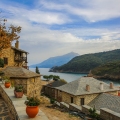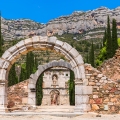An almost 500 kilometers long route is based on some of the most read, commented, even feared literary passages of the last two thousand years. It includes seven ancient Hellenistic cities in modern Turkey, where early Christians would read the prophetic words of the Book of Revelation.
The current tours are carried out in three to four days by car, visiting two places each day of the trip. The walking tour is not advisable because it is not signposted.
Following the biblical text, the itinerary begins in Ephesus, by the sea. What was once a bursting city is now an extraordinary archaeological site, much visited by tourists because of its excellent state of preservation.
Among its monuments is the Temple of Artemis, one of the Seven Wonders of the Ancient World, where St. Paul is said to have preached the Gospel. The library of Celsus also stands out, as does the Roman amphitheater. Very close to the site there is another important place for Christians: the house of the Virgin Mary.
The second city of the Apocalypse is Izmir, the ancient Smyrna, now a modern coastal city, where visiting the Cathedral of St. John is a must. Although the building dates from the 19th century, it houses relics that bear witness to the vibrant history of early Christianity.
The third city leaves the coast and enters the Anatolian peninsula. It is ancient Pergamon, now located near the Kestel Marsh. Pergamon was home to the second most famous library of antiquity after Alexandria. Today, visitors can get to its Acropolis, where the remains of the theater and the temple of Athena stand out.
Of the fourth city, Thyatira (today’s Akhisar) very few visible remains remain. Some of the ruins and remaining sarcophagi can be seen today at the site of Tepe Mezarı, the “mountain cemetery,” which was excavated in the 1970s, as well as the remains of a civilian basilica.
The fifth city, Sardes, is now a well-preserved archaeological park just 9 km away from modern Salihli. Once there, pilgrims can visit the remains of the acropolis and those of a beautiful 3rd century synagogue, which recalls several passages from the Acts of the Apostles about the missionary activity of the Apostle Paul.
The sixth city, Philadelphia (which literally means “the city of brotherly love” in Greek), is located on the same site as modern-day Alaþehir. Here, visitors walk through the remains of another Basilica of St. John, built in the 7th century.
The seventh city is now an archaeological site on the outskirts of the Turkish city of Denizli. Its ruins are still imposing: buildings, bridges, baths and theaters –as well as the remains of a church believed to be the recipient of a rather bitter prophecy: “because thou art lukewarm, and neither cold nor hot, it will come to pass, that I shall spew thee out of my mouth.”




